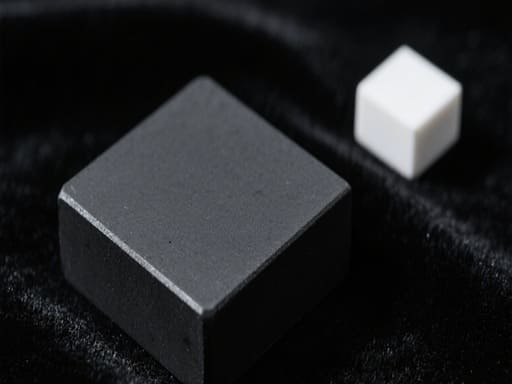Why Is B4C (Boron Carbide) Called the Hardest Ceramic Material?
Boron carbide (B4C) is widely known as one of the hardest ceramic materials in the world. This ultra-hard material is often used in applications that require exceptional wear resistance, impact strength, and chemical stability. From armor plating and abrasive powders to neutron absorption in nuclear reactors, its role spans multiple industries. But what exactly makes B4C stand out among ceramics, and why is it frequently referred to as the “hardest ceramic material”?
This article dives deep into the science behind boron carbide’s extreme hardness, comparing it with other ceramics and even metals. It also explores its structure, applications, processing techniques, and how it compares to similar advanced materials.
At Advanced Ceramic Hub, we specialize in high-quality boron carbide ceramic products, ensuring optimal performance for industrial and scientific applications.

What Is B4C (Boron Carbide)?
Boron carbide (chemical formula: B4C) is a covalent ceramic composed of boron and carbon atoms arranged in a highly stable crystalline structure. It is black in appearance, tough, and has a very low density, making it suitable for lightweight but high-strength applications.
One of the most unique aspects of B4C is its rhombohedral crystal structure, which is responsible for its exceptional hardness. It was first discovered in the 19th century and has since become a go-to material in high-performance industries.
Basic Properties of B4C Compared to Other Materials:
| Property | B4C (Boron Carbide) | Alumina (Al2O3) | Tungsten Carbide | Silicon Carbide |
| Hardness (Vickers) | ~35 GPa | ~18 GPa | ~24 GPa | ~25 GPa |
| Density (g/cm³) | 2.52 | 3.95 | 15.6 | 3.21 |
| Melting Point (°C) | ~2763 | ~2072 | ~2870 | ~2730 |
Boron carbide’s unique combination of extreme hardness and lightweight nature gives it a clear edge in many demanding environments.
Explore our high-quality boron carbide ceramic products.
Why Is B4C the Hardest Ceramic Material?
The extreme hardness of B4C stems from its strong covalent bonds and its complex crystal structure, which resists plastic deformation. In terms of mechanical performance, it is only slightly behind diamond and cubic boron nitride, yet it is significantly more affordable and chemically stable in high-temperature environments.
The bonding forces between boron and carbon atoms result in minimal slip systems, which means the atoms do not easily move past each other under stress, thus making it extremely hard.
Hardness Comparison of Advanced Ceramics:
| Material | Vickers Hardness (GPa) |
| Boron Carbide (B4C) | ~35 |
| Silicon Carbide (SiC) | ~25 |
| Alumina (Al2O3) | ~18 |
| Zirconia (ZrO2) | ~12 |
| Silicon Nitride (Si3N4) | ~16 |
This exceptional hardness is the key reason B4C is used in protective gear, grinding tools, and other high-wear applications.
How Does B4C Compare to Metals in Hardness and Performance?
Compared to metals, boron carbide offers far greater hardness but lacks ductility. Metals are often tougher in terms of impact absorption due to their ability to deform plastically, while ceramics like B4C are brittle but far harder and more wear-resistant.
Metals such as steel or titanium cannot match B4C in hardness, but excel in applications needing flexibility and structural load-bearing.
B4C vs. Common Engineering Metals:
| Property | B4C | Steel | Titanium | Aluminum |
| Hardness (GPa) | ~35 | ~4–9 | ~2–3 | ~1–2 |
| Density (g/cm³) | 2.52 | 7.8 | 4.5 | 2.7 |
| Ductility | Very low | High | Moderate | High |
Although metals offer superior toughness, B4C’s hardness makes it ideal where abrasion and weight matter most, like in ballistic protection.
What Are the Main Applications of B4C?
Due to its hardness, thermal stability, and neutron absorption capacity, B4C is used across multiple industries. These applications make use of its strengths, particularly in extreme or highly abrasive environments.
Common Applications of Boron Carbide:
| Application Area | Use Case Example |
| Armor | Body armor, tank armor |
| Abrasives | Nozzles, polishing, grinding wheels |
| Nuclear Industry | Neutron shielding in reactors |
| Electronics | Semiconductor components |
| Aerospace | Lightweight structural parts |
The versatility of B4C lies in its unique mix of lightweight, hardness, and chemical resistance.
How Does B4C Compare to Other Ceramics?
While ceramics like alumina and zirconia are widely used, B4C surpasses them in terms of hardness and abrasion resistance. Each ceramic has its own strengths, but few can match boron carbide when both hardness and lightweight are required.
Comparison of B4C with Other Ceramics:
| Property | B4C | SiC | Al2O3 | ZrO2 | Si3N4 |
| Hardness (GPa) | ~35 | ~25 | ~18 | ~12 | ~16 |
| Fracture Toughness | Low | Moderate | High | High | High |
| Thermal Conductivity | High | High | Medium | Low | Medium |
While not as tough as some ceramics, B4C’s hardness makes it ideal for wear-dominant applications.
Request a custom quote for boron carbide ceramic products.
What Are the Processing Challenges of B4C?
Although B4C offers exceptional performance, it is difficult to process due to its hardness and brittleness. Sintering at high temperatures without additives often leads to low density, which affects mechanical strength. Processing usually involves hot pressing or using sintering aids like carbon or silicon.
Common B4C Processing Methods:
| Method | Key Features |
| Hot Pressing | High density, high cost |
| Reaction Sintering | Easier shape control, lower density |
| Spark Plasma Sintering | Rapid densification, precise control |
Overcoming processing challenges is key to unlocking more widespread applications of B4C.
Why Is B4C Used in Magnetic and Electronic Applications?
In magnetic and electronic systems, materials must withstand thermal cycling and mechanical wear. B4C’s chemical inertness and thermal conductivity make it ideal in these fields. Additionally, its ability to absorb neutrons without swelling makes it perfect for nuclear electronic components.
B4C in High-Tech Applications:
| Industry | B4C Functionality |
| Nuclear Reactors | Neutron absorbers |
| Semiconductor | High-durability wafer supports |
| Magnetic Systems | Non-reactive wear-resistant structural use |
In high-tech environments, B4C’s physical resilience gives it a long-term advantage.
FAQ
| Question | Answer |
| What is the chemical formula of boron carbide? | B4C, composed of boron and carbon. |
| Is B4C the hardest ceramic? | Yes, it is one of the hardest known ceramics with ~35 GPa hardness. |
| Where is B4C commonly used? | Body armor, abrasives, nuclear shielding, electronics. |
| Can B4C be machined easily? | No, due to its hardness, it requires diamond tools for machining. |
| How does B4C compare to metals? | Harder and lighter, but more brittle and less tough. |
These common questions help clarify B4C’s role and performance in advanced applications.
Conclusion
Boron carbide (B4C) stands out as the hardest ceramic material due to its exceptional hardness, low density, and chemical resistance. Its unique properties make it invaluable in defense, aerospace, electronics, and energy sectors. Though processing and brittleness present challenges, ongoing innovations are expanding their usage across high-performance applications.
As industries continue to seek lighter, harder, and more resilient materials, B4C will remain at the forefront of advanced ceramic solutions.
Looking for high-quality ceramic products? Contact us today!
